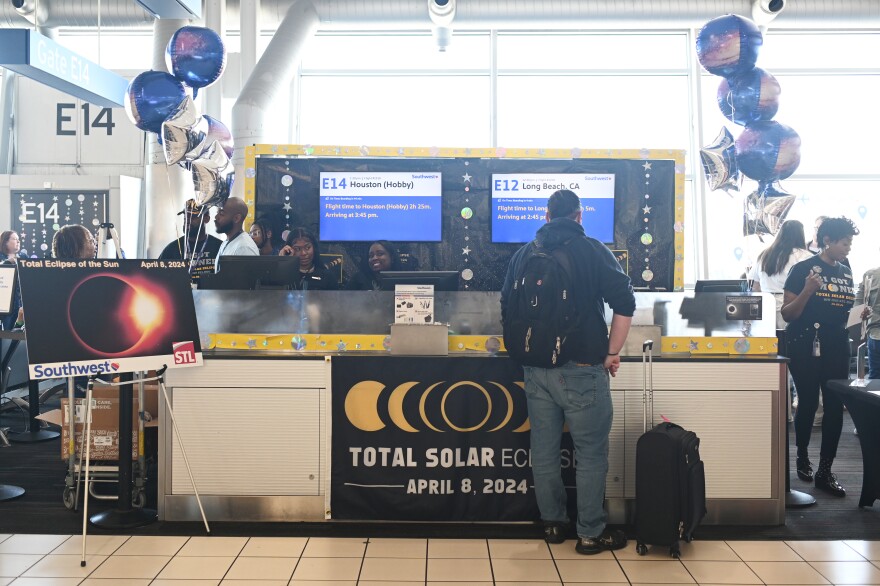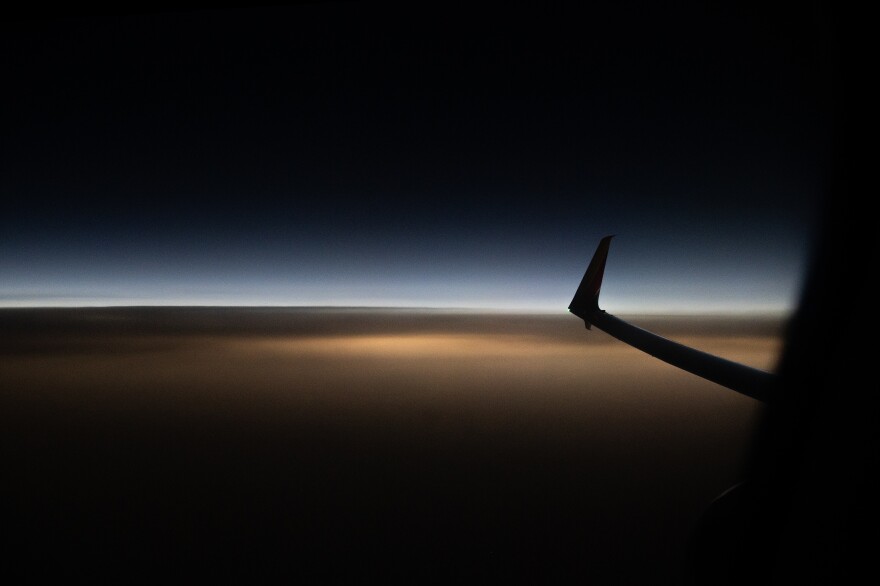While earthbound eclipse watchers Monday kept an eye on the weather forecast and hoped for clear skies, some found a different view: above the clouds, on a plane passing through the zone of totality.
The scene at Lambert International Airport’s Gate E-14 was festive, with balloons, cookies and hula hoop contests greeting travelers.
Many had traveled to St. Louis to board an early afternoon flight for Houston, one of three flights Southwest Airlines officials identified as offering the best chance to view the total solar eclipse from midair.
“We had to take a flight from Albuquerque to Denver, from Denver to St. Louis, now St. Louis to Houston,” said Tristan Martinez. “Then Houston to Phoenix and then Phoenix back to Albuquerque tonight. All today. We’ll be home at 1 a.m.”


She was traveling with her teenage son Niko Martinez, an astronomy buff who carried a digital telescope that takes photos. He hoped to take advantage of the eclipse to photograph the sun’s corona — not unlike a mission NASA planned for the day.
Other passengers were less scientifically minded but knew they wanted a dramatic view of the celestial event.
“I just started reading about it and seeing photos that other people are taking from previous eclipses from airplanes, and I thought that’s something I want to do,” said Babette Lewis, who flew to St. Louis from Minneapolis for the eclipse flight.

Matthew Ames started planning for an airborne eclipse view last year. He scheduled business meetings this week in Kansas City and Philadelphia — with a quick flight from St. Louis to Houston in between, before heading home to Florida.
“I’ve never gotten to see a total eclipse,” he said. “I’m 50 years old. Who knows if this will be my only opportunity to see one, so, I’m blessed to be on the flight. I’m excited to see it.”
As passengers boarded, airline staff handed out goody bags, including eclipse glasses, moon pies and eclipse-themed cookies.
After takeoff, the captain announced the view of totality would happen early in the flight.
The view toward the sun was nearly straight up above the plane, but the pilot banked sharply to the left and then the right, giving passengers on either side of the plane a chance to crane their necks for a glimpse through the windows.

The cabin darkened as the flight approached the zone of totality, with the blue sky visible a few minutes before rapidly dimming into a haze. A thin strip of dark blue sky hovered high above while the view straight out and down grew darker. The ground was no longer visible.
For several minutes, passengers traded window places and took turns laying eyes on a view of the total eclipse unencumbered by clouds.
Views for many passengers lasted for only seconds at a time, as the plane made hard turns to allow everyone a shot at collecting the prized memory or photograph. But in those moments there was the indelible image of a black disc surrounded by an eerie crown of flames high in the sky.


The plane lingered in the zone of partial eclipse for longer, as some passengers stayed glued to the windows to watch the sun reemerge, while others shared their photos of totality.
At the arrival gate in Houston, airline staff gave passengers an ovation as they deplaned — adding one last unexpected layer to an unusual journey.
Niko Martinez wasn’t able to take the perfect, time-lapse photo of the eclipse that he hoped to. But from 30,000 feet in the air, he saw plenty of interest.
“Did you see the solar flares?” he asked a fellow passenger excitedly, comparing notes from an eclipse viewing like few others.







